How To Find FL Studio Plugins
Создавайте группу онлайн, продвигайте свою музыку, покупайте собственные биты, звуковые партии и делитесь с нами своим битом или треком в качестве лупа без лицензионных отчислений. Сотрудничайте, чтобы создавать биты онлайн с лучшими производителями лупов со всего мира на Форуме для музыкантов и создателей битов. Будьте в курсе музыкальных новостей и изучайте видеоуроки FL Studio и статьи в блоге . Бесплатные загрузки музыкального программного обеспечения DAW, пакеты VST и инструментов для FL Studio, Pro Tools, Logic, Ableton, а также способы использования самого популярного бесплатного программного обеспечения DAW, плагинов Fruity Loop, MIDI и многого другого.
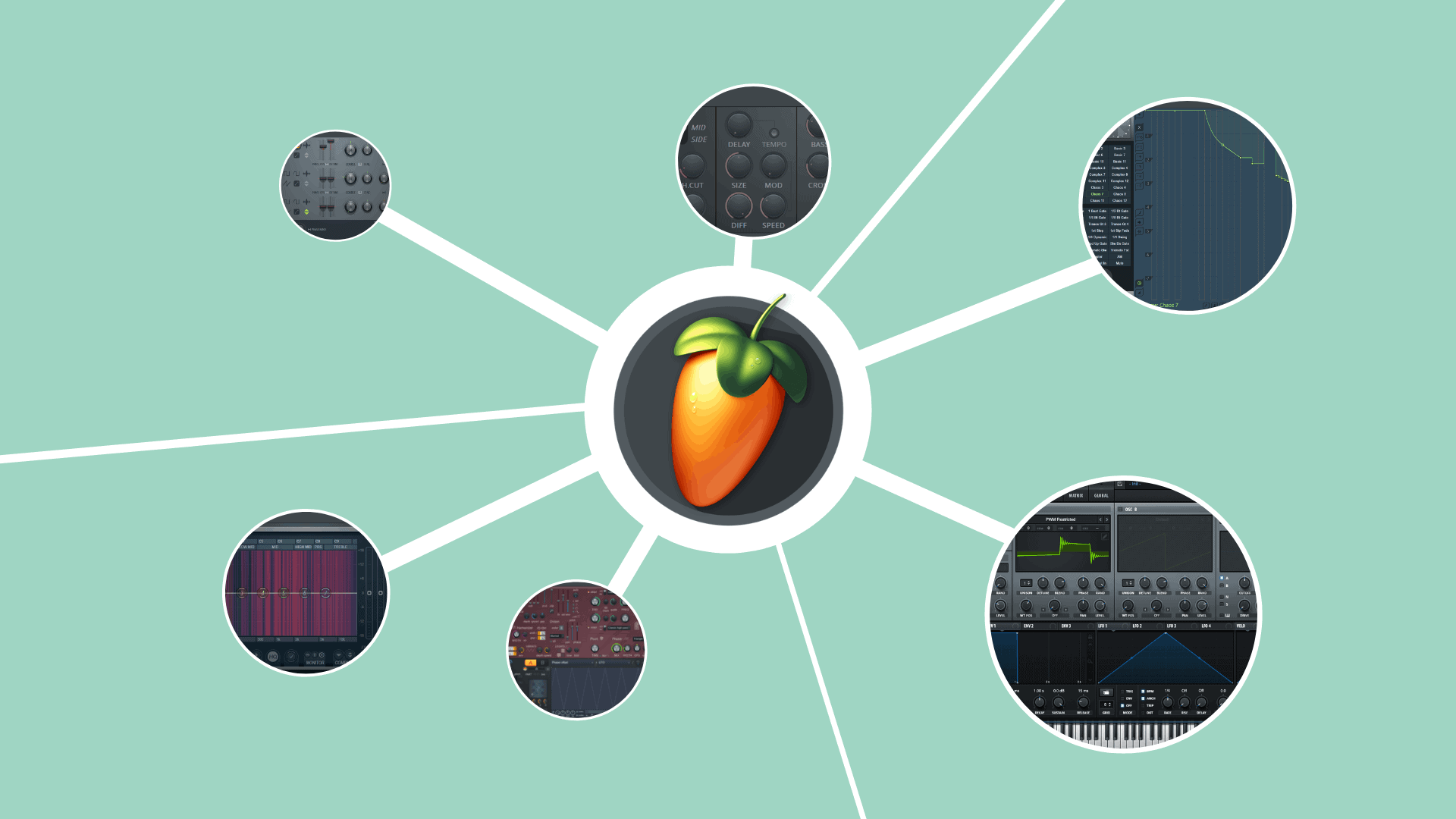

FL Studio Plugins: How To Easily Use and Find Them
If you’ve been using FL Studio for a minute, you’ll have seen this beast of a list pop up when you go to load up something.
This is the FL Studio plugins list, and it shows you all the devices you have in your library.
Looks kinda overwhelming, right?
If you’re new to FL Studio, you won’t have any clue what plugins are.
Or maybe you’re looking at how to use these plugins.
You could even be looking at finding some good third-party VSTs to add to this list.
Whatever your case may be, this article aims to answer your questions. So make sure to read the whole thing to really understand plugins and be able to use them to their fullest potential.
So, let’s jump into it.
What is a Plugin?
Depending on your music production journey, you might know what plugins are already. But if you don’t, they are extra pieces of software you can use with FL Studio (or any other DAW).
Hence the word: plug-in.
But what do plugins actually do that FL Studio can’t do?
While a majority of DAWs (like FL Studio) have great feature sets that are more than capable of creating high-quality in music, sometimes the basic functionality just doesn’t cut it.
Perhaps you want to synthesize more complex bass sounds, or want to have a reverb sound with more analogue character? Maybe you’re just not having enough fun, and you want to expand your options and experiment.
This is where plugins come in – to fill the gap.
Generators, Instruments and Effects? What?
Plugins come in two varieties. The first plugin type is an instrument (FL Studio prefers the term generator) format, which is designed to synthesise, sample and produce sounds.
The sounds are produced when you input notes into them through a MIDI device or on the piano roll.
These are loaded up either by dragging from the browser, or by clicking the + icon on the Channel Rack.

The second is an effect format, which is designed to process, manipulate and change the incoming sound. These plugins are added into the FL Studio mixer inserts on the right.
Note that the order matters when it comes to loading up effect plugins in the mixer. If you add reverb after the delay, the reverb will be applied after the delay is applied to whatever is being inputted before that.

FL Studio includes its own plugins in some of their bundles. Because they know that plugins can add expanded functionality and creative sonic possibilities.
But the majority of plugins you’ll find in producers’ arsenals aren’t included with FL Studio.
Ever heard of Serum by Xfer Records? That’s a third-party synthesizer plugin.
Plugins made by third parties are something you can purchase or download separately to FL Studio, usually made by a variety of different manufacturers.
What’s a VST?
Plugin? VSTs? What? All these words!
Another word used interchangeably with ‘plugin’ is ‘VST’. But many producers get confused here, they aren’t necessarily the same thing. VST is a type of plugin format. There are a variety of plugin formats:
- VST (Virtual Studio Technology) – compatible with most DAWs
- VST3 – a newer VST version compatible with some DAWs
- AU (Audio Units) – compatible with most DAWs on macOS only
- AAX (Avid Audio eXtension) – compatible with newer Pro Tools versions
- RTAS – compatible with older Pro Tools versions
- Native – not really a format, just when a plugin is hard-wired to only work with the DAW it came with
Many instrument plugins also have standalone versions that you can use outside of FL Studio or a DAW environment – this is usually an option when you install a plugin on your computer.
What should you use? It doesn’t really matter, they all work the same and don’t sound any different. Just make sure your computer supports it.
VST is the most popular and supported, but Audio Units are great on macOS because they are native to the platform.
FL Studio Plugins
As previously mentioned, FL Studio comes with a great set of plugins. In fact, it’s one of the reasons people pick FL Studio over other DAWs. These are a ‘Native’ format unique to FL Studio, not VST or anything.
You can find a LOT of information on each of them online, but it requires hours of research and understanding just to know how to use them.
When I first used FL, I just wanted to get in a start getting my hands dirty, without feeling like I’m drowning.
So let’s delve in and demystify the main ones for you. We won’t cover all of them, but we’ll get to the important ones.
Also, most of the FL Studio plugins included have quite a steep learning curve, so we aren’t going to explain the types of synthesis or processing behind each plugin, as that is a separate, lengthy discussion.
We’ll include links to other resources for the FL Studio plugins below, if that’s what you’re after. This is a basic rundown of each plugins’ features and interface.
Generators
3x Osc
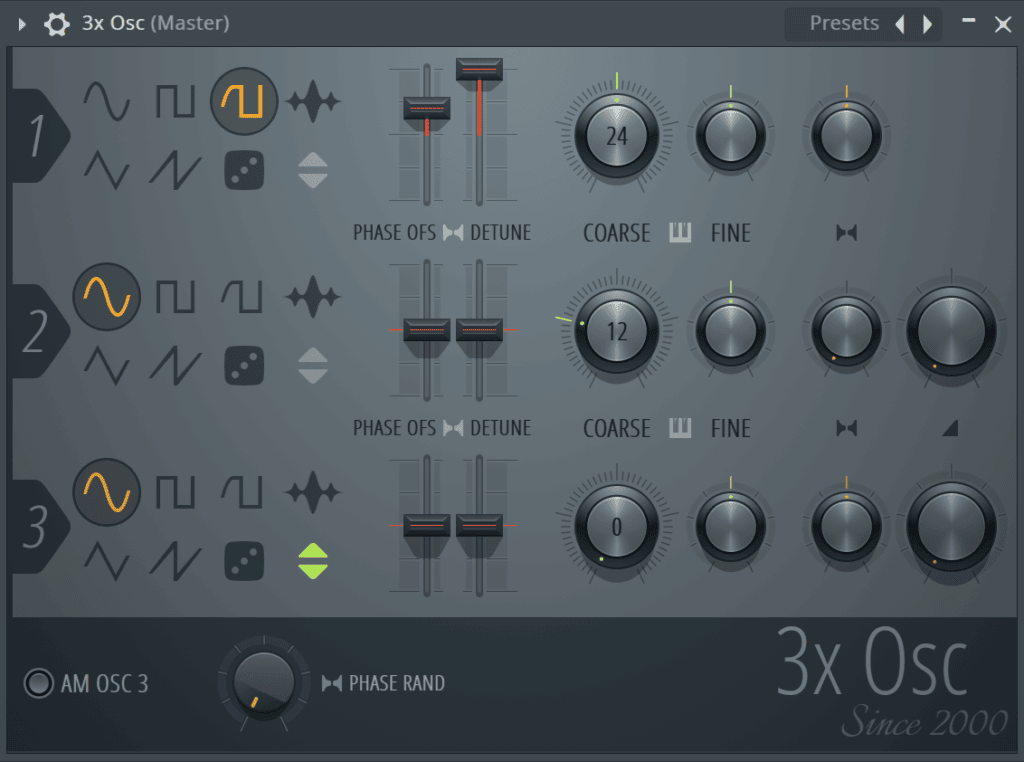
I can’t think of a more basic synthesizer plugin that’s included with FL Studio, but as they say, limitations can be powerful. Load this thing up and you can make some killer sounds.
So many people swear by this instrument, that there’s even a challenge dedicated to it.
It’s fairly self-explanatory, so much so that I can give you the basic rundown in a paragraph – you get 3 oscillators on which you can choose between 6 waves (saw, sine, triangle, square, noise and a strange rounded square) with each having the ability to also be a sampler.
In addition, you also get the standard level control, pan control, fine and coarse pitch tuning, detune and phase offset. Oscillators 2 and 3 come with mix controls that blend their signal in with Oscillator 1’s signal.
And that’s it – but don’t let the simplicity repel you. Play around with it and find out for yourself.
Sytrus

AKA FL Studio’s premier FM synth. What’s an FM synth you ask? It stands for Frequency Modulation, and it’s an advanced type of synthesis that’s able to produce some unique sounds that you can’t get using other synth types.
Once again, the interface isn’t anything too spectacular, and in actuality, it’s pretty daunting. In my early days of production it was the kind of thing that made me scared to click on the fruity icon on my desktop.
Since then, they’ve revamped it with a less fear-inducing design, but the overwhelming feeling you get when gazing into the interface hasn’t gone away.
Consisting of 6 operators, some filters and FX, you can make an insane variety of sounds – from rip-roaring growly basses to beautiful tonal pads.
Most of the sound comes from the Matrix on the right, where you can see a wall of knobs. Essentially, you modulate the different operators against each other to produce different tones and textures.
If you’re after a full course on Sytrus, check out this course from Sonic Academy.
Harmless
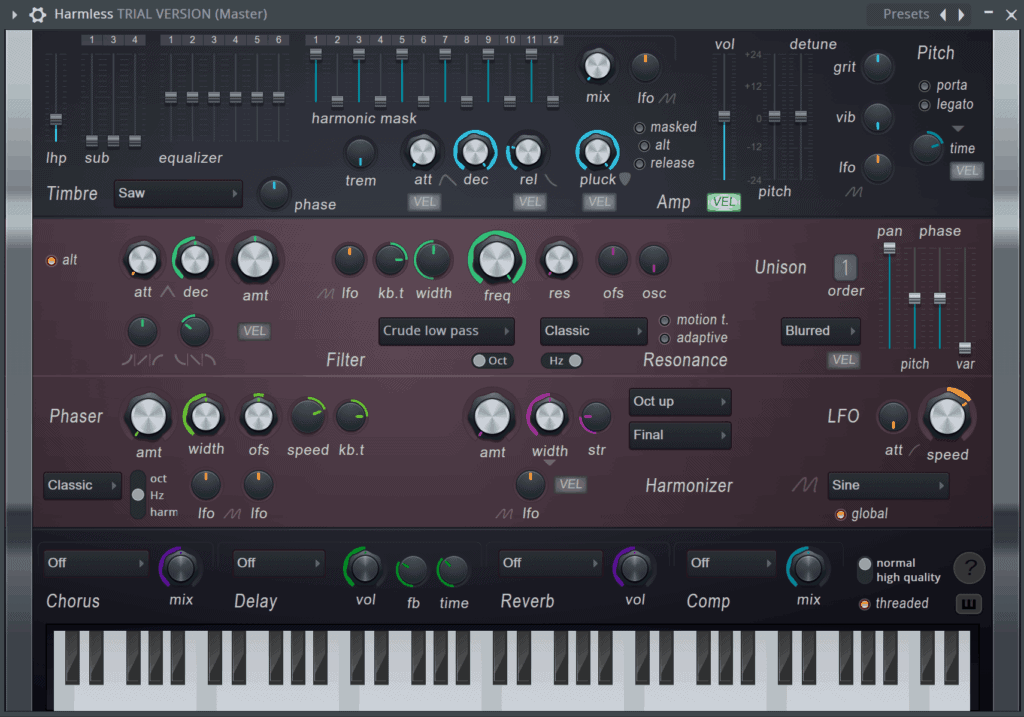
Harmless is an incredible subtractive-additive synthesis plugin, with an array of unique features. If you’ve heard of Massive or Sylenth1, Harmless is the closest native synth to those.
According to the FL Studio website, the synth was designed to have 5 main sections:
- Timbre – The oscillator or sound generation controls.
- Unison – Voice thickening & stereoizing effect.
- Phaser – Creates totally unique phasing and partial based effects, only possible with Harmless.
- LFO – Modulation source for adding motion and evolution to sounds.
- Effects – Chorus, Delay, Reverb & Compression.
Note: Harmless only comes with the Signature Bundle and up
Harmor

The staple of many bass producers’ studios, Harmor is an extended version of Harmless including a resynthesis engine.
What’s that you ask? Well if you make a sound, you can take it, treat it as the new basis, and apply the synthesis and FX process all over again.
If you’re interested in making crazy bass sounds with this plugin, check out some of SeamlessR’s tutorials on YouTube. The stuff he makes is unbelievable.
Other features include:
- Image Synthesis – drag in images to hear what they sound like
- FX – Click on the FX section in the bottom right to uncover a wide variety of distortions, choruses, delays and reverbs
- Layering – See the A/B section in down in the left-of-center? That means you can have two sounds going at the same time.
- Visuals – Harmor is great for visualising what’s happening to your sounds. Click the arrow on the right to show the spectrogram.
You can use Harmor in other DAWS on Windows, but on macOS your stuck inside FL Studio with this one.
Note: Harmor is only in the All Plugins Bundle
Slicex

Being the bigger brother of the less-featured Fruity Slicer, Slicex is quite a capable sample slicing instrument. In a sentence: it chops up drum loops.
If the interface doesn’t make it apparent, Slicex isn’t feature-shy. With a variety of modulation options to alter the volume, filter, speed, velocity and way more, you can chop loops both intuitively and creatively.
Like most looping instruments, it chops them automatically and assigns them across the keyboard.
Of course, you can change the chops by adjusting the markers down the bottom, while naming them for the sake of definition.
Once again, there are Edison-like audio editing features, including fade in/out, chopping, normalising and heaps more. It’s one of those things that I recommend just getting in and exploring for yourself.
Honourable (Brief) Mentions
- Fruity Granulizer – takes samples, splits them into small segments, rearranges them and makes sick sounds
- Fruity Slicer – As mentioned before, this is a simpler slicing plugin that you can load up and just use
- BassDrum – quite a nice drum synthesizer for kicks
- Transistor Bass – great 303 emulation with some extra bells and whistles
- FL Keys – the infamous keyboard sounds of FL Studio, including a grand piano, Rhodes, blah and blah
- SimSynth – A nice analogue synth emulation
- Ogun/Autogun – Make some pretty wacky textures using physical modelling and some other technical magic
- Morphine – Really cool synth, got a bit of a learning curve.
- Toxic Biohazard – Confusing but powerful
Effects
Fruity Parametric EQ 2
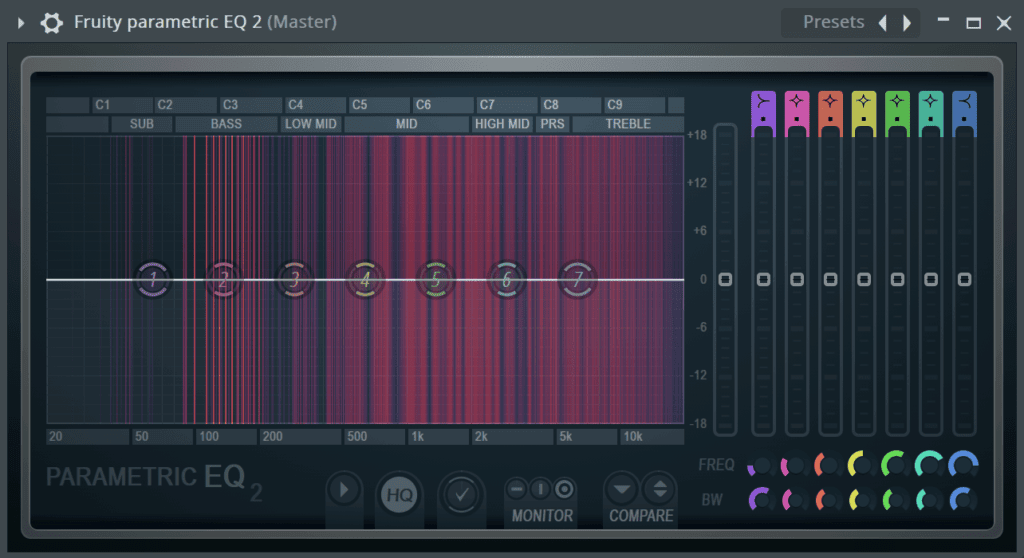
A powerful yet simple EQ plugin that helps balance the different frequencies in a sound.
One unique feature that helps EQ 2 to stand out is the intuitive frequency visualiser – brighter lines indicate louder frequencies. Great for both mixing and mastering.
You’ve got 7 different bands you can manipulate the frequency and bandwidth on, but also 7 different curve possibilities:
- Low-Pass – cuts all frequencies above a certain point
- High-Pass – cuts all frequencies below a certain point
- Band-Pass – cuts all frequencies above and below a certain point, allowing a narrow range of frequencies through
- Notch – cuts a specific range of frequencies completely out of the spectrum
- Low Shelf – attenuates a group of frequencies below a certain point
- Peak – attenuates a range of frequencies at a specific point
- High Shelf – attenuates a group of frequencies above a certain point
Fruity Limiter
Ahh yes, that plugin that gets loaded on your master every time you open FL Studio. But what does it do?
Well first and foremost, it’s a Limiter – a device that allows no audio to pass over 0dB by applying heavy compression. Yet most people don’t realise it also have a standard Compressor function, and is the ideal way to side-chain something.
Fruity Delay 3
You may be surprised to hear that this plugin is a more recent addition to the FL Studio library. Or not, because it has the number 3 next to it.
Regardless, it’s definitely an improvement on iterations one and two. You can get so many awesome delays out of this thing, with features like feedback distortion, modulation and tone control, in addition to standard features like delay time, feedback, filter, delay model and dry/wet control.
If you’re new to the land of delays, Image-Line themselves have a comprehensive tutorial on their YouTube channel.
Fruity Reeverb 2
With a reputation for it’s cheesy sound, you might wonder why I’ve included Reeverb 2 amongst the ‘main’ plugins. But don’t listen to internet purists – Reeverb 2 sounds as good as the person plonked in front of the DAW can make it.
You’ve got quite a number of controls here, but the important ones are: delay, size, decay, dry/wet, high/low cut and ER level.
These control the bulk of the length, density, loudness, colour and shape of the reverb tail – the thing that makes your sound feel like it’s in another space.
Fruity Convolver
I’m quite surprised when FL Studio users say they haven’t delved into the sonic capacity of the Convolver. Maybe because the interface causes people to freak out and shut FL Studio down.
So what is it? A convolution reverb plugin – different to the standard algorithmic reverbs you’ll find (like Reeverb 2).
Instead of relying on the aforementioned maths to calculate a precise space, it uses a pre-existing sound called an Impulse Response (IR) and superimposes that over the input signal, taking your bedroom saws to the Taj Mahal and back.
FL Studio includes a great library of IR’s, but you can find a ton for free with a swift Google search.
Among the standard knobs and features of a reverb plugin, you’ll find Edison-like audio editing tools to customize your IR exactly the way you desire, including a useful EQ section to alter pesky frequencies in the original sample.
Pro-tip: for some crazy sound design, try dragging in a sound that isn’t designed to be a IR, into the sampler at the bottom. Because breaking tools is the funnest, right?
Edison
If you’ve picked up FL Studio from another DAW like Ableton, this is where all sorts of audio processing and recording happens.
With a myriad of tools including fade ins and outs, normalization, looping, delay, blur (a reverb-type effect) and so much more than I can write here, you’ll be playing with it for hours.
As mentioned before, FL Studio has tried to unify it’s user experience across plugins by including the same suite of editing features across the board.
This way, you’re not reaching for the manual every time you want to figure out how a new plugin works.
One thing to note about Edison is that because of it’s native integration, it ‘overtakes’ the transport keyboard shortcuts (like play, pause and record) when being used, as this allows for a seamless recording experience.
Gross Beat
The holy grail of FL Studio to be honest. Honestly, when I first used this plugin I didn’t get it. I mean, I thought it was alright, but nothing fantastic.
But after getting more into production and increasing my knowledge, you can see how practical and creative it can be.
Sidechaining, pitch shifting, stuttering, volume fading, turntable emulation, you name it.
Yet this is all achieved by drawing an envelope for both the pitch and volume over a defined period of time (e.g. 1 bar).
Note: Gross Beat only comes with the Signature Bundle and up.
Effector
While it’s no replacement for a dedicated effect type, Effector is a fun way to get creative with your processing.
Combining phasers, reverbs, distortions and pretty much every effect type into one plugin, it allows intuitive modulation of parameters on an X-Y pad, with a customisable mod rate.
Think of it like a discount Turnado, Effectrix or Glitch 2. Good for some applications, not so much for others, mostly because there’s not too much to the plugin.
Vocodex
Yoy-bass lovers and vowel-sound fanatics – this is your plugin.
Vocodex is an advanced Vocoder plugin. I’m not going to take the time to explain in depth what a vocoder is, but essentially it uses a voice (modulator) to modulate a carrier, which can be a synth or any sound.
It’s how you get those robot-esque sounds in many of Daft Punk’s tracks.
Except Vocodex is like that on steroids. You can change vowel sounds, make it sound like multiple people, and way more.
Maximus
Multiband compression and limiting to the next level. Maximus is (mostly) a mastering plugin that makes things sound super loud.
It has 3 bands, for low, mid and high, and then a master processing that comes after all three.
Each band has its own visualizer and set of controls, like gain, attack and release, and the graph on the left, which represents the ratio and threshold.
Honourable Mentions
- Soundgoodizer – Look, as much of a meme as it may be, it packages some Maximus presets quite nicely into an easy interface. It can actually, in fact, sound good.
- Hardcore – Guitar pedals inside a DAW? You got it.
- Fruity Chorus – it’s a basic chorus plugin.
- Fruity Flanger – it’s a basic flanger.
- Fruity Phaser – basic phaser.
- Fruity Waveshaper – a basic waveshaper for custom distortion.
- Fruity Soft Clipper – adds some nice soft distortion in a simple interface.
Third-Party Plugins
Beyond the many included plugins, there are an infinite number of free and paid options made by a variety of manufacturers.
You’ll never be without plugins again, really.
These work in any DAW, of course, but hey, if you’ve read this far then I’m assuming you use FL Studio.
Free Plugins
Xfer OTT
So you want your sounds to be super-squashed? Like over-the-top squashed? Then this is the compressor for you.
Modelled off the ‘OTT’ Multiband Dynamics preset in Ableton, this plugin brings the unique texture to any DAW, including FL.
Includes gain control, 3-band threshold control, time and depth controls.
Voxengo Span
It’s hard to come across a decent spectrum analyzer. Especially one that’s free.
Span is incredible for the price (free) and has all sorts of functionality, including FFT time customisation, pitch and frequency analysis and multiple spectrums from different audio sources. Super cool.
u-he Tyrell N6
I had to include a free instrument, and Tyrell is insanely great value as a free plugin, because it’s synthesis engine is premium-level quality.
Yes, it’s simple and compact, but that’s all you might need. Check out some of the presets on this thing, they’re actually interestingly good.
The filter module on this thing is also adapted from Diva, u-he’s top-of-the-line analogue emulation synth. So don’t waste this one.
Paid Plugins
While there are numerous free plugins that are sufficient for both making good music and sparking creativity, sometimes you need something that’s had the time and effort worked into it.
The problem with free plugins is that they’re hit and miss, whereas if you buy something, you’re a lot more likely to get utility out of it.
Not just because there is a financial incentive for the company in selling something of value, but also because there is also a financial investment on your part, giving you the kick up your producer ass you probably need to make music.
Here’s some popular and high-quality options on the market:
Xfer Serum
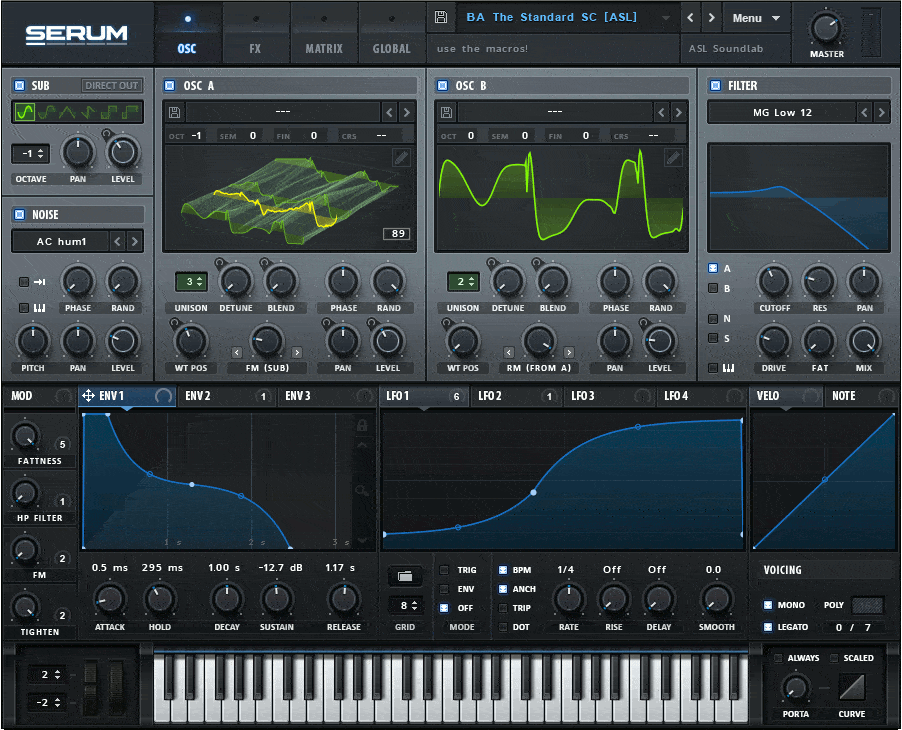
It’s both number 1 on Splice and the go-to synth plugin in many electronic music producers’ studios for a reason. It’s damn sick, that’s why.
Serum is the brainchild of Steve Duda, a producer and software engineer who runs Xfer Records.
Basically, it’s an advanced wavetable synthesizer with subtractive, additive and FM capabilities all built in, and that’s only scratching the surface.
What’s a wavetable synthesizer? Imagine you could tell your oven to make any food you wanted ever. That’s the culinary equivalent of Serum.
You can import any sound and turn it into a wavetable, by splitting the sound into series of audio cycles that get repeated and scanned through. Kind of like making a stop motion film and putting all the pictures together at the end, but in reverse.
You can either buy or rent to own Serum, which is a pretty sick deal. So click the link above to grab it. We also recommend it for EDM Foundations.
iZotope Ozone 8

AKA mastering made easy all in one plugin. Ozone is a suite plugin, meaning it rolls a lot of the features from a group of standard plugins into one simple interface.
It comes in a few different versions, but at the heart of it, the result is the same – quality mastered audio.
Ozone has some crazy futuristic features that I should mention, like Tonal Balance Control (which is basically automatic EQ), Spectral Shaping (removes frequencies surgically per band) and Track Referencing per section. Makes some tedious mastering tasks too easy.
To sum it up, Ozone includes the following modules (they are standalone too in the Advanced version):
- Spectral Shaper
- EQ
- Dynamic EQ
- Post EQ
- Maximizer
- Imager
- Exciter
- Dynamics
- Vintage Limiter
- Vintage Tape
- Vintage EQ
- Vintage Compressor
Once again, Splice offers the option to either buy or rent to own Ozone, so click on the link to get to their site.
Native Instruments Massive
Although it’s a bit older (and it’s about to get a revamp), Massive was the centre of many music producers’ studios for years and years, responsible for many synth sounds. And it still is for many people, remaining at #11 on Splice.
It’s a wavetable synth, like Serum, but without the crazy visuals and custom import options. It’s got some great, unique filters and other processing options though, making it great if you like a bit of restriction.
Valhalla VintageVerb
One of my personal favourite reverbs, Valhalla VintageVerb is insanely good for thick, retro-style reverb.
It can emulate a 1970’s colour, a 1980’s colour or a NOW colour, which texturizes the reverb in different ways.
It also has a bunch of different modes for different sounding spaces, and a myriad of presets for different creative needs.
While you’re at it, you should just check out all of Valhalla’s reverbs. They’re all $50 each.
Other Resources
If you didn’t know, there are literally thousands, if not millions of free and paid plugins out there for FL Studio, made by hobbyists and companies alike. Here are a few resources that curate them well. Be warned though, you’ll find both gems and garbage in these sorts of places.
- Music Production Software Guide – Our own list of curated software, including plugins. We cut out the junk in this one, but not all are free.
- VST4Free – So many free plugins here, so if you need something specific, give this a look.
- KVR Audio – More of a full-featured plugin forum, that features a variety of plugins with download options.
- LANDR Blog –A bit more on the curated side again, LANDR lists 200 free plugin options on their blog.
- Splice – Splice curates a lot of plugins, and also ranks them depending on who uses them. Pretty cool.
